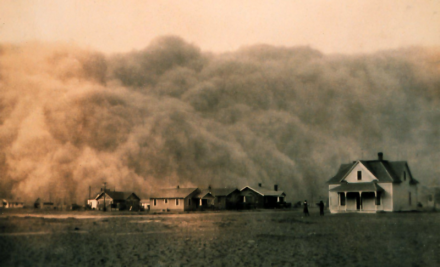
For decades, the heartland of America has been the breadbasket of the world. Unfortunately, those days will shortly come to an end. The central United States is rapidly drying up and dust bowl conditions will soon return. There are a couple of major reasons for this. Number one, the Ogallala Aquifer is being depleted at an astounding pace. The Ogallala Aquifer is one of the largest bodies of fresh water in the entire world, and water from it currently irrigates more than 15 million acres of crops. When that water is gone we will be in a world of hurt. Secondly, drought conditions have become the “new normal” in many areas of Texas, Oklahoma, Kansas and other states in the middle part of the country. Scientists tell us that the wet conditions that we enjoyed for several decades after World War II were actually the exception to the rule and that most of time time the interior west is incredibly dry. They also tell us that when dust bowl conditions return to the area, they might stay with us a lot longer than a decade like they did during the 1930s. Unfortunately, without water you cannot grow food, and with global food supplies as tight as they are right now we cannot afford to have a significant decrease in agricultural production. But it is not just the central United States that is experiencing the early stages of a major water crisis. Already many other areas around the nation are rapidly developing their own water problems. As supplies of fresh water get tighter and tighter, some really tough decisions are going to have to be made. Fresh water is absolutely essential to life, and it is going to become increasingly precious in the years ahead.
Most Americans have never even heard of the Ogallala Aquifer, but the truth is that it is one of the most important bodies of water on the globe. It covers well over 100,000 square miles and it sits underneath the states of Texas, New Mexico, Oklahoma, Colorado, Kansas, Nebraska, Wyoming and South Dakota.
Water drawn from the Ogallala Aquifer is used to water more than 15 million acres of crops. Without this source of water, the United States would not be the breadbasket of the world.
That is why what is happening right now is so alarming.
The following are 20 signs that dust bowl conditions will soon return to the heartland of America….
#1 The Ogallala Aquifer is being drained at a rate of approximately 800 gallons per minute.
#2 According to the U.S. Geological Survey, since 1940 “a volume equivalent to two-thirds of the water in Lake Erie” has been permanently lost from the Ogallala Aquifer.
#3 Decades ago, the Ogallala Aquifer had an average depth of approximately 240 feet, but today the average depth is just 80 feet. In some areas of Texas, the water is gone completely.
#4 Scientists are warning that nothing can be done to stop the depletion of the Ogallala Aquifer. The ominous words of David Brauer of the Ogallala Research Service should alarm us all….
“Our goal now is to engineer a soft landing. That’s all we can do.”
#5 According to a recent National Geographic article, the average depletion rate of the Ogallala Aquifer is picking up speed….
Even more worrisome, the draining of the High Plains water account has picked up speed. The average annual depletion rate between 2000 and 2007 was more than twice that during the previous fifty years. The depletion is most severe in the southern portion of the aquifer, especially in Texas, where the water table beneath sizeable areas has dropped 100-150 feet; in smaller pockets, it has dropped more than 150 feet.
#6 According to the U.S. National Academy of Sciences, the U.S. interior west is now the driest that it has been in 500 years.
#7 It seems like the middle part of the United States experiences a major drought almost every single year now. Last year, “the drought of 2011” virtually brought Texas agriculture to a standstill. More than 80 percent of the state of Texas experienced “exceptional drought” conditions at some point, and it was estimated that about 30 percent of the wheat fields in Texas were lost. Agricultural losses from the drought were estimated to be $3 billion in the state of Texas alone.
#8 Wildfires have burned millions of acres of vegetation in the central part of the United States in recent years. For example, wildfires burned an astounding 3.6 million acres in the state of Texas alone during 2011. This helps set the stage for huge dust storms in the future.
#9 Texas is not the only state that has been experiencing extremely dry conditions. Oklahoma only got about 30 percent of the rainfall that it normally gets last summer.
#10 In some areas of the southwest United States we are already seeing huge dust storms come rolling through major cities. You can view video of a giant dust storm rolling through Phoenix, Arizona right here.
#11 Unfortunately, scientists tell us that it would be normal for dust bowl conditions to persist in parts of North America for decades. The following is from an article in the Vancouver Sun….
But University of Regina paleoclimatologist Jeannine-Marie St. Jacques says that decade-long drought is nowhere near as bad as it can get.
St. Jacques and her colleagues have been studying tree ring data and, at the American Association for the Advancement of Science conference in Vancouver over the weekend, she explained the reality of droughts.
“What we’re seeing in the climate records is these megadroughts, and they don’t last a decade—they last 20 years, 30 years, maybe 60 years, and they’ll be semi-continental in expanse,” she told the Regina Leader-Post by phone from Vancouver.
“So it’s like what we saw in the Dirty Thirties, but imagine the Dirty Thirties going on for 30 years. That’s what scares those of us who are in the community studying this data pool.”
#12 Experts tell us that U.S. water bills are likely to soar in the coming years. It is being projected that repairing and expanding our decaying drinking water infrastructure will cost more than one trillion dollars over the next 25 years, and as a result our water bills will likely approximately triple over that time period.
#13 Right now, the United States uses approximately 148 trillion gallons of fresh water a year, and there is no way that is sustainable in the long run.
#14 According to a U.S. government report, 36 states are already facing water shortages or will be facing water shortages within the next few years.
#15 Lake Mead supplies about 85 percent of the water to Las Vegas, and since 1998 the level of water in Lake Mead has dropped by about 5.6 trillion gallons.
#16 A federal judge has ruled that the state of Georgia has very few legal rights to Lake Lanier, and since Lake Lanier is the main water source for the city of Atlanta that presents quite a problem.
#17 It has been estimated that the state of California only has a 20 year supply of fresh water left.
#18 It has been estimated that the state of New Mexico only has a 10 year supply of fresh water left.
#19 Approximately 40 percent of all rivers in the United States and approximately 46 percent of all lakes in the United States have become so polluted that they are are no longer fit for human use.
#20 Eight states in the Great Lakes region have signed a pact banning the export of water from the Great Lakes to outsiders – even to other U.S. states.
Unfortunately, it is not just the United States that is facing a shortage of fresh water in the near future. The reality is that most of the rest of the world is in far worse shape than we are. Just consider the following stats….
-According to the United Nations, the world is going to need at least 30 percent more fresh water by the year 2030.
-Global demand for fresh water tripled during the last century, and is now increasing faster than ever before.
-According to USAID, one-third of the people on earth will be facing severe or chronic water shortages by the year 2025.
-Of the 60 million people added to the cities of the world each year, the vast majority of them live in deeply impoverished areas that have no sanitation facilities whatsoever.
-It has been estimated that 75 percent of all surface water in India has been heavily contaminated by human or agricultural waste.
-Sadly, according to one UN study on sanitation, far more people in India have access to a cell phone than to a toilet.
-Every 8 seconds, somewhere in the world a child dies from drinking dirty water.
–Due to a lack of water, Saudi Arabia has given up on trying to grow wheat and will be 100 percent dependent on wheat imports by the year 2016.
-Each year in northern China, the water table drops by an average of about one meter due to severe drought and overpumping, and the size of the desert increases by an area equivalent to the state of Rhode Island.
-In China, 80 percent of the major rivers have become so horribly polluted that they do not support any aquatic life at all at this point.
-In sub-Saharan Africa, drought has become a way of life. Collectively, the women of South Africa walk the equivalent of the distance to the moon and back 16 times a day just to get water.
It has been said that “water is the new gold”, and unfortunately we are getting close to a time when that may actually be true.
Without water, none of us could survive for long. Just try not using water for anything for 12 hours some time. It is a lot harder than you may think.
We can’t grow our food in a pile of dust. Unfortunately, many areas of the heartland of America are slowly but surely heading in that direction.
History tells us that it is only a matter of time before dust bowl conditions return to the central United States. We have used irrigation and other technologies to delay the inevitable, but in the end it cannot be stopped.
Let us hope that the return of dust bowl conditions can be put off for as long as possible, but let us also prepare diligently for the worst.











 Getty Images/Keystone/Staff
Getty Images/Keystone/Staff



